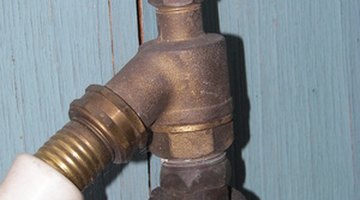How to Replace the Faucet in a Laundry Room for a Washer
The basement is not a place for fancy faucets. In particular, the faucet that supplies your washing machine is likely a simple compression-style faucet like the ones you have outside your house.

Things You Will Need
- 2 pipe wrenches
- Thread lubricant
- Plumbing tape
- Pipe cutter
- Wire brush
- Flux
- Propane torch
- Lead-free solder
- Pliers
It is called a hose bib or spigot, and you install it by screwing or soldering it onto a galvanized steel or copper water supply line. It will last for many years of normal use, but eventually corrode and need to be replaced, especially if your water supply is highly mineralized.
Replacing Threaded Spigots
-
Turn off the water supply to the spigot and open it to relieve water pressure.
-
Grip the spigot with one pipe wrench and the water pipe with another. Hold the pipe securely while you turn the spigot counterclockwise. If it is welded by corrosion and won't turn, spray lubricant onto the threads, wait five minutes, then try again. Turn the spigot with the wrench until it moves freely, then finish unscrewing it by hand and remove it.
-
Wrap plumbing tape clockwise around the threads on the end of the water line and screw on a replacement spigot. Turn it by hand until it won't turn anymore, then finish turning it with the wrench. Hold the water pipe with the other wrench while you tighten the spigot.
-
Turn on the water and check for leaks. If you detect any, tighten the spigot until the leaking stops.
Replacing Soldered Spigots
-
Turn off the water and open the spigot to relieve pressure.
-
Cut off the old spigot with a pipe cutter. Tighten the cutter around the pipe about 1 inch away from the spigot joint, then rotate it through 360 degrees. When you return to the starting point, tighten the cutter a little more and rotate again. Continue doing this until the pipe separates. Let the water completely drain from the water pipe.
-
Clean the end of the pipe with a wire brush. Spread flux on the end of the pipe and on the inside of the slip joint of a new spigot and slide the spigot onto the pipe.
-
Heat the joint with a propane torch until the flux smokes and begins to spit. Remove the torch and touch the end of a coil of lead-free solder to the joint. Move the solder around the pipe as it melts and wicks into the joint, fusing the spigot onto the pipe.
-
Turn on the water and check for leaks. If your solder connection leaks, turn off the water and open the spigot to drain the water. Heat the joint and pull the spigot off with pliers. Clean the pipe, apply more flux and re-solder it.
Tip
If your old spigot is leaking, you may not have to replace it. You can stop leaks by tightening the nut on top of the spigot, or by removing the valve stem and replacing the washer on the bottom of the stem.
Warning
Don't try to solder copper pipes until you are sure there is no water inside. The water will absorb the heat and vaporize, preventing the pipe from getting hot enough to melt the solder.
Tips
- If your old spigot is leaking, you may not have to replace it. You can stop leaks by tightening the nut on top of the spigot, or by removing the valve stem and replacing the washer on the bottom of the stem.
Warnings
- Don't try to solder copper pipes until you are sure there is no water inside. The water will absorb the heat and vaporize, preventing the pipe from getting hot enough to melt the solder.
Writer Bio
Chris Deziel has a bachelor's degree in physics and a master's degree in humanities. Besides having an abiding interest in popular science, Deziel has been active in the building and home design trades since 1975. As a landscape builder, he helped establish two gardening companies.
Photo Credits
- faucet image by Joann Cooper from Fotolia.com
- faucet image by Joann Cooper from Fotolia.com
More Articles


